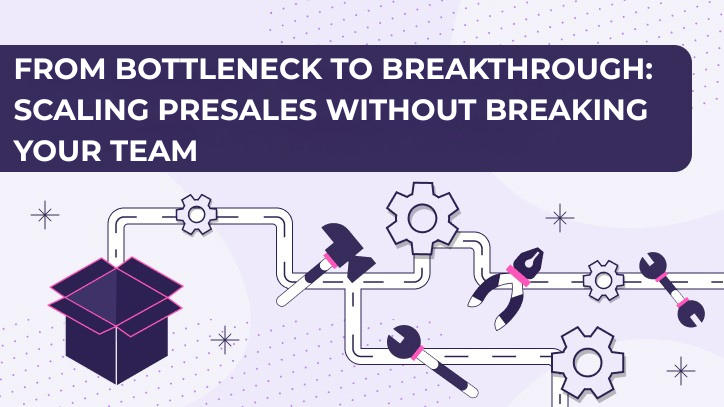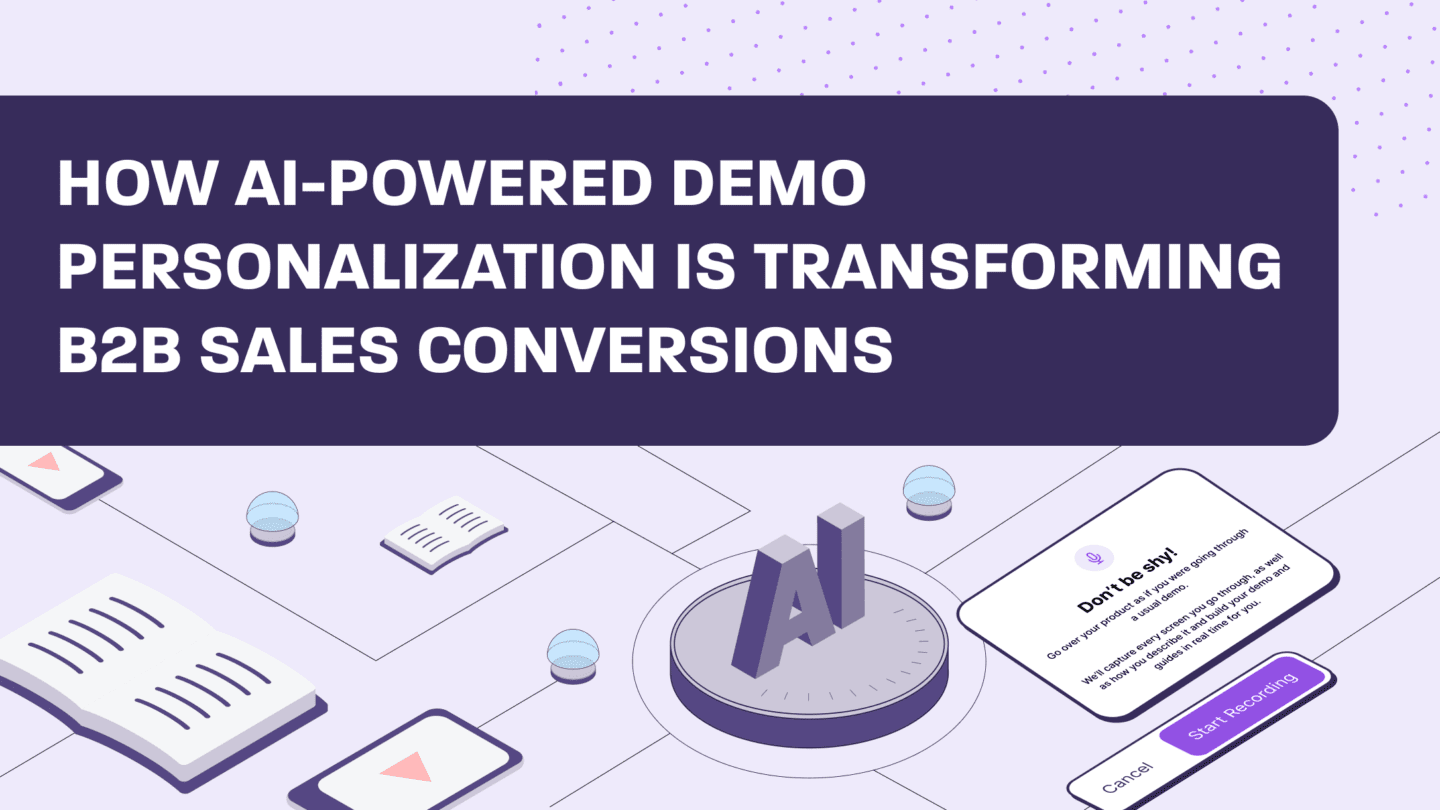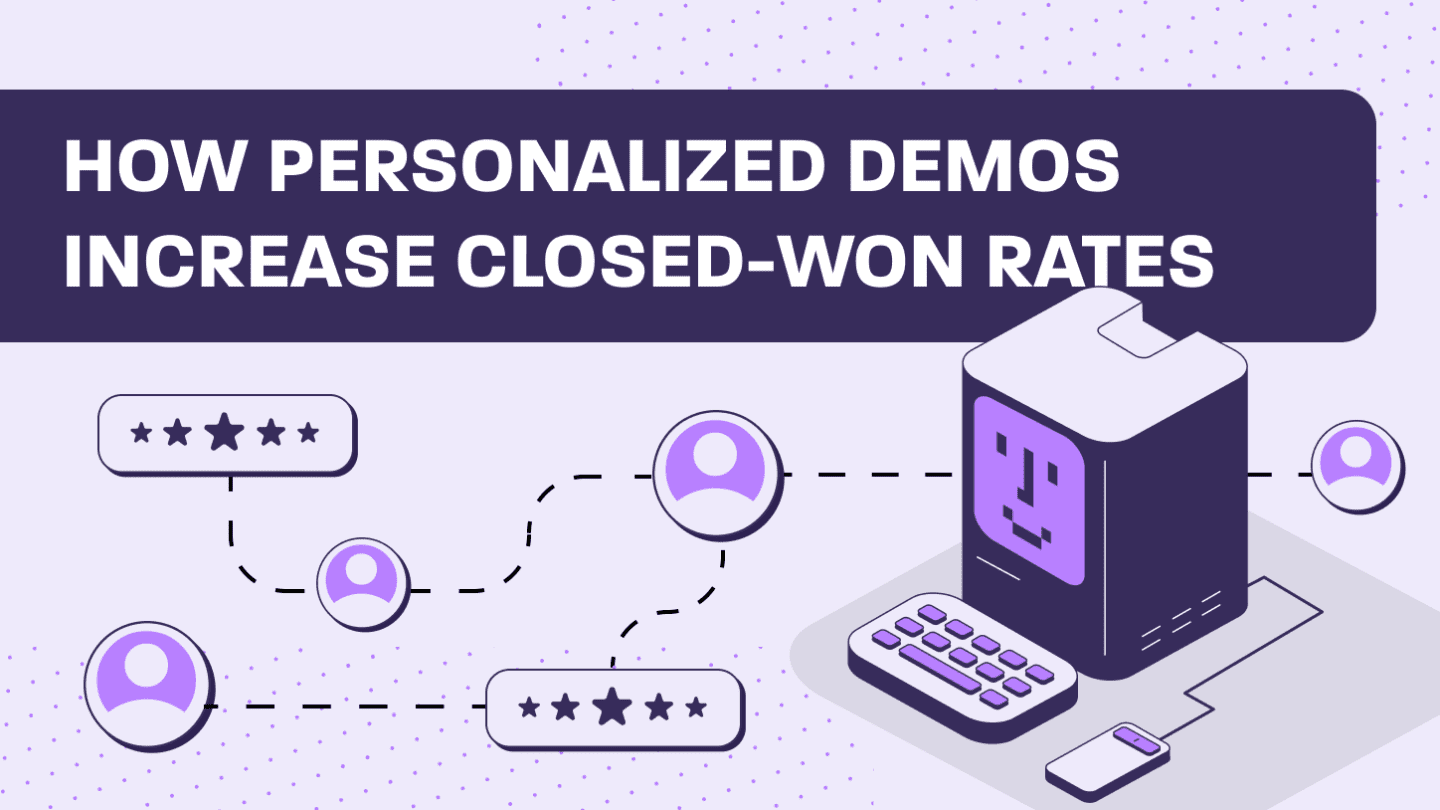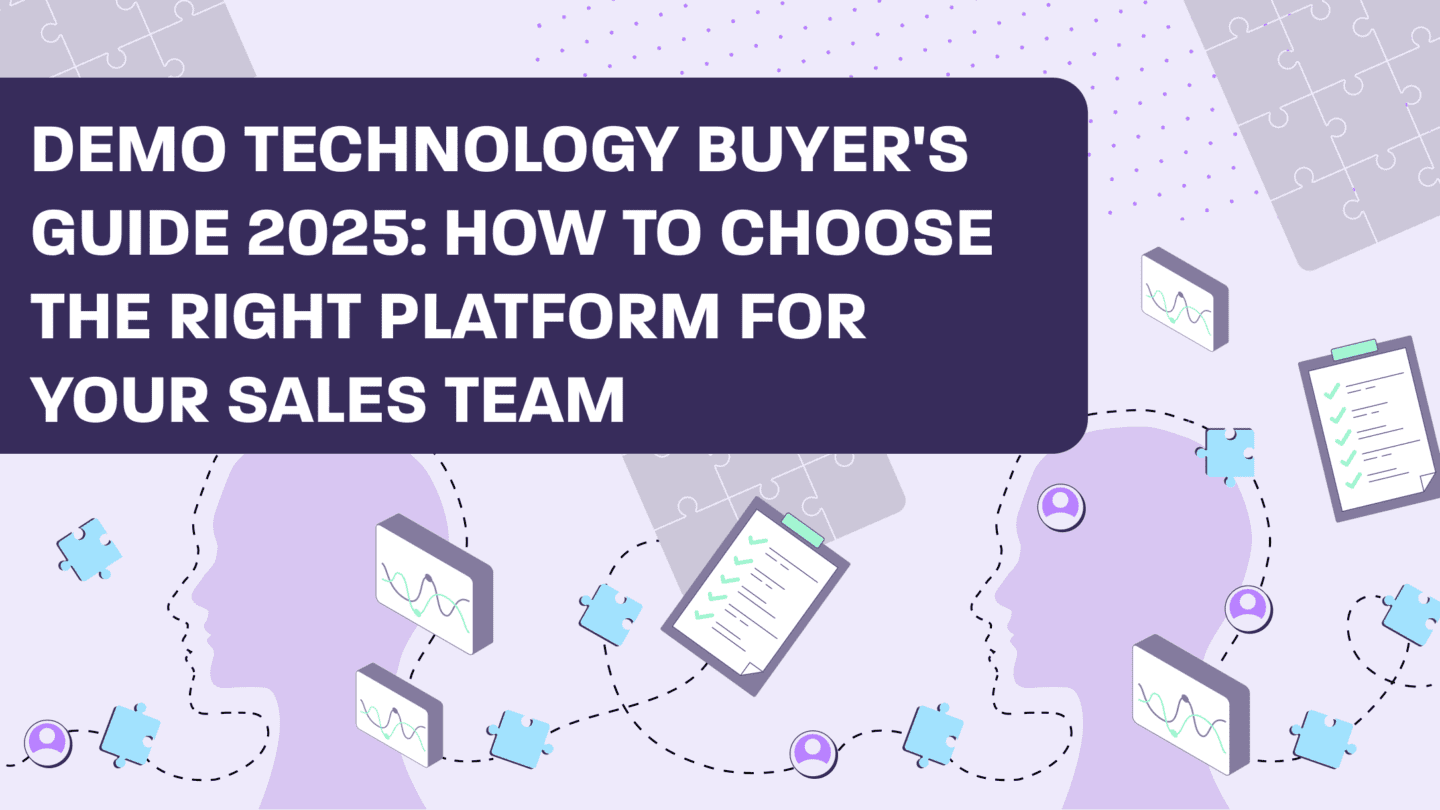To better understand the evolving role of presales and solutions engineering—and more importantly, the critical challenges of scaling presales in today’s competitive B2B sales environment—we partnered with Wynter, a leading B2B message testing platform, to conduct a comprehensive targeted survey. Our primary goal was to uncover the real-world challenges, priorities, and tooling strategies that scaling presales teams face daily.
The survey captured valuable insights from 50 senior professionals across companies ranging in size from mid-market to enterprise. Notably, the majority represented the SaaS and technology sectors. Furthermore, respondents held diverse roles spanning sales engineering leadership, revenue operations, product marketing, and sales enablement—thereby offering a truly holistic view of the presales function.
This comprehensive report summarizes key findings from the research, specifically including:
- How presales teams are overextended and under-leveraged
- Why demo pain points directly correlate with team resourcing
- Which tools and tactics are being used (or strategically avoided) to scale demos effectively
- What executive perceptions reveal about presales value and investment priority
As a result of these insights, go-to-market teams, product marketing, and enablement leaders can now optimize demo strategies and maximize presales impact throughout 2025 and beyond.
Key Findings
Teams Value Presales But Often Underutilize It
Remarkably, 74% of respondents believe the presales/solutions engineering function helps their team win deals. However, many describe presales as “an underutilized resource with more potential value to unlock,” consequently pointing to significant missed opportunities in maximizing SE impact.
Staffing Levels Heavily Influence Demo Effectiveness
Most importantly, teams that identified as understaffed reported higher friction across the board—from burnout and delays to poor demo customization and inadequate analytics. Meanwhile, adequately staffed teams still faced issues, particularly with demo personalization, coordination, and consistency.
Demo Ownership and Effectiveness Challenges
Unfortunately, demo responsibilities are fragmented across roles, leading to inconsistent buyer experiences. Additionally, customization and maintenance of demo environments are significant pain points, even for adequately staffed teams working on scaling presales operations.
Tool Adoption Gaps
Surprisingly, many teams still rely on standard tools (e.g., presentation software) rather than dedicated demo platforms. In fact, only a few teams utilize modern demo platforms like Walnut for scaling presales effectively.
Too Few SEs, Too Many Demo Fires
You might initially see staffing as merely an ops issue, but it directly affects your ability to deliver consistent, scalable demos that convert. When presales teams stretch too thin, demo quality inevitably drops. Even with enough team members, if they lack the right tools and support, performance still suffers. The pain just manifests in different places. Here’s what our scaling presales research uncovered.
Understaffed = Under Pressure
Teams that flagged themselves as understaffed painted a clear picture of the scaling presales challenge:
Demos are draining, not scaling.
First, burnout is real: “Presales is stretched thin” came up repeatedly. SEs are juggling too many requests, consequently leading to delays and missed follow-ups.
Second, customization slows everything down: Tailoring demos for different use cases eats up precious time—time these scaling presales teams simply don’t have.
Third, environments break down: Keeping demo instances stable, bug-free, and up to date becomes a daily battle.
Finally, no visibility into what’s working: Without proper analytics, these teams can’t optimize or prioritize their scaling presales efforts.
Adequate Staffing Isn’t a Cure-All
Even teams that felt “well-staffed” hit significant roadblocks—not because they lacked people, but because they lacked proper process and tools for scaling presales.
Personalization is still a time suck: Headcount helps, but teams are still manually tailoring demos instead of implementing scalable solutions.
Scheduling becomes a logistical nightmare: Coordinating across AEs, SEs, and prospects delays the entire process.
Demo quality remains inconsistent: Without shared templates or centralized messaging, the buyer experience varies dramatically from rep to rep.
Analytics remain an afterthought: These teams still struggle to track which demos are actually moving deals forward in their scaling presales efforts.
The Exception: Overstaffed Teams
Interestingly, a small but telling slice of our respondents described themselves as “overstaffed”—and reported virtually no major demo-related pain points. Their experience reinforces a clear trend:
More bandwidth = more breathing room = better buyer experience.
What This Means for GTM Leaders
Ultimately, throwing people at the problem isn’t enough. Without the right demo infrastructure, even the best-staffed teams will waste time on redundant work, inconsistent narratives, and manual follow-ups.
What you need for successful scaling presales isn’t just more SEs—it’s a smarter, more scalable way to deliver demos.
Disjointed Teams, Disjointed Demos
Our scaling presales research reveals a shocking truth: demo ownership is essentially a free-for-all. Inconsistent experiences, misaligned expectations, and internal chaos aren’t just workflow issues—they’re major obstacles to scaling presales effectively. Fix the demo hand-offs, unify your narrative, and watch your win rates soar. Stop the scattered stories and start orchestrating success.
One of the clearest signs of operational friction in the presales process is the lack of clarity around demo ownership. Our research revealed that demo execution is often inconsistently assigned—sometimes it’s entirely the domain of SEs, while in other organizations, AEs are expected to take the lead, particularly in early-stage or lower-complexity deals.
This fragmented approach creates significant ripple effects across the entire sales cycle:
Inconsistent buyer experiences: Without a shared playbook, demo quality varies wildly depending on who’s presenting—consequently causing confusion and eroding trust.
Misaligned expectations: AEs may prioritize speed over technical depth, while SEs may over-index on features rather than business outcomes. As a result, buyers are left to piece together a narrative that should have been clear from the first click.
Internal inefficiencies: Reps duplicate efforts, SEs are pulled in late to “rescue” broken narratives, and nobody has a clear picture of what’s been shown, promised, or resonated.
Across all staffing levels, customization and maintenance of demo environments present considerable challenges for teams focused on scaling presales, even for teams with adequate staffing. The ongoing need to tailor demos to individual prospects and keep environments up-to-date consumes significant resources and time.
This strain directly impacts efficiency and can lead to errors or outdated content, further affecting buyer perception. In today’s buyer-led world, this lack of cohesion isn’t just a process gap—it’s a growth risk. When demo responsibility is scattered, so is the story you’re telling your customers.
It’s time for teams to move beyond “who has capacity” and shift toward strategic demo orchestration: clearly defined roles, consistent handoffs, and shared demo assets that reinforce a unified product narrative across the entire buyer journey when scaling presales.
Customization Is the #1 Pain Point
If there’s one demo challenge that cuts across company size, team structure, and tooling when scaling presales—it’s this: customization is crushing productivity. Consider these compelling stats:
According to Forrester, sales representatives dedicate merely 23% of their workweek to selling activities, with the remaining time consumed by administrative tasks, including manual demo customization.
Furthermore, Gartner’s research indicates that 77% of B2B buyers perceive their purchasing journey as extremely complex or challenging. This complexity necessitates tailored sales interactions, which, without efficient systems, can overwhelm sales teams working on scaling presales.
Additionally, a recent report indicates that team members spend approximately 3.5 hours preparing for each demo. Considering that at least three demos are typically required to close a deal, this amounts to over 10 hours of preparation per opportunity. Moreover, 30% of these demos are delivered to poorly qualified prospects, leading to substantial time inefficiencies.
SEs and AEs alike report spending excessive time customizing demos for each deal—a major barrier to scaling presales effectively. From swapping logos and user data to adjusting flows for various industries or use cases, personalization has become a significant time drain.
And it doesn’t stop there:
Environments break: Every tweak risks introducing bugs or breaking functionality.
Consistency suffers: Ad hoc customization means every demo tells a slightly different story.
Speed stalls: By the time the demo is ready, the buyer’s already moved on.
Everyone agrees that personalization matters for scaling presales. But without the right system, it’s not scalable—and that turns demo creation into a bottleneck instead of a revenue lever.
Outdated Tools Are Holding You Back
Despite the rising complexity of B2B sales, most teams are still stuck in the demo dark ages when it comes to scaling presales.
Very few survey respondents reported using modern platforms like Walnut. Instead, the most common “demo stack” still includes:
- Static presentation decks pretending to be product walkthroughs
- Hard-coded sandboxes that break with every release
- Or worse—no formal tooling at all
This patchwork approach might have worked a decade ago, but today’s buyers expect significantly more. They want tailored, interactive experiences—not static slides and screenshots.
The problem? Without purpose-built demo infrastructure, teams can’t scale, personalize, or measure their demo efforts effectively. The result is missed opportunities, wasted SE hours, and a fragmented buyer journey that hinders scaling presales efforts.
A modern demo stack moves beyond static presentations and unstable sandbox environments. Instead, it centers on an interactive demo platform like Walnut, which enables the creation of personalized, consistent, and measurable demos without extensive coding.
The modern demo stack integrates seamlessly with other tools like CRMs, providing a smooth flow of data and insights. Unlike traditional methods relying on generic slides or fragile environments, a modern stack empowers presales teams to deliver engaging experiences tailored to each prospect, track demo performance, and ultimately drive better sales outcomes while scaling presales operations.
It’s time to replace duct tape with a demo platform that actually supports how modern teams sell and scale.
Scaling Presales Strategically: Demo Tactics That Protect Your Team and Drive Results
Prioritize Demo Scalability to Protect SE Resources
As teams look toward scaling presales efficiently, it’s essential to reduce the burden on already stretched sales engineering teams. Understaffed SE organizations often face burnout, slower response times, and missed opportunities. To alleviate this, organizations should introduce reusable, on-demand demos that empower AEs to deliver value earlier—thereby freeing up SEs to focus on complex, high-impact work.
Next, to support scalable presales efforts, it’s critical to standardize demo narratives and environments. This approach reduces the time spent customizing demos from scratch and ensures a consistent buyer experience across the entire sales team. Templates not only speed up delivery—they also safeguard brand and product messaging while scaling presales operations.
Clarify Demo Ownership Across the Deal Cycle
To reduce friction and confusion between roles, clearly define demo ownership at each stage of the sales process. For example, AEs might handle early discovery or business-value demos, while SEs step in for technical validations or deep integrations. This strategic approach aligns responsibilities and supports a more predictable, scalable presales process.
Leverage Interactive Demo Platforms to Boost Efficiency
To bring these scaling presales strategies to life, consider implementing a purpose-built interactive demo platform like Walnut. These advanced tools enable low-code customization, real-time personalization, and analytics-driven optimization—all of which are essential for scaling presales operations without increasing headcount.
Track Demo Performance to Drive Continuous Improvement
Finally, don’t stop at deployment. To truly excel at scaling presales, presales leaders must track demo engagement, usage patterns, and conversion impact. These insights help teams refine messaging, improve effectiveness, and retire underperforming assets—making every demo a growth opportunity.
Establish comprehensive metrics around demo usage, engagement, and impact on pipeline conversion. Use these insights to optimize what’s working—and sunset what’s not in your scaling presales efforts.
Interactive and Scalable Demo Creation: Here’s What to Look For
To effectively address the challenges presales teams face, particularly concerning scalability, personalization, collaboration, and analytics, an interactive demo platform offers a powerful solution for scaling presales. The following outlines the essential features to consider when selecting such a platform.
Interactive and Scalable Demo Creation
No-Code/Low-Code Builder: Enables presales teams to create high-fidelity, interactive demos without requiring extensive technical skills.
Branching Logic: Allows for “choose-your-own-adventure” demo paths to cater to different buyer personas and use cases.
Personalization: Supports dynamic variables for tailoring demos with customer-specific details like logos, names, and industry terms.
Unbreakable Demos: Ensures that demos are stable and functional, even when showcasing complex workflows or integrations.
Centralized Demo Management
Demo Library: A centralized repository for storing, organizing, and accessing demo assets effectively.
Version Control: Tracks changes and maintains multiple versions of demos for different audiences or product updates.
Access Permissions: Role-based access control to ensure that only authorized team members can edit or share demos.
Collaboration and Workflow Integration
Real-Time Collaboration: Enables multiple team members to work on demos simultaneously, with features like commenting and feedback.
CRM and MarTech Integrations: Native integrations with tools like Salesforce, HubSpot, and Marketo to embed demos into existing workflows seamlessly.
Demo Playlists: Bundles multiple demos into guided journeys for a seamless storytelling experience.
Advanced Analytics and Insights
Engagement Tracking: Monitors metrics like time spent, click-throughs, and interaction with CTAs to understand buyer behavior.
Stakeholder Identification: Identifies key decision-makers based on demo shares and account-level activity.
Performance Insights: Uses AI to analyze demo performance and recommend optimizations for higher engagement and conversion rates.
Ease of Use and Onboarding
Intuitive Interface: A user-friendly platform that minimizes the learning curve for presales teams.
Onboarding Support: Access to tutorials, templates, and customer success resources to accelerate adoption.
Scalability: Ability to handle increasing demo demands as the business grows.
Security and Compliance
Data Privacy: Adherence to data protection regulations like GDPR and CCPA.
Access Control: Secure sharing options to ensure demos are only accessible to intended recipients.
Audit Trails: Tracks demo usage and edits for compliance and accountability.
Support for Complex Use Cases
Integration Showcasing: Demonstrates complex integrations (e.g., Salesforce, Epic) without requiring live environments.
Technical Storytelling: Maintains consistency in showcasing technical features and workflows.
Offline Access: Allows demos to be shared and viewed without requiring an active internet connection.
Business Impact
Lead Qualification: Converts demo interactions into Demo Qualified Leads (DQLs) to improve lead quality.
Reduced Presales Workload: Automates repetitive tasks, freeing up time for strategic activities.
Faster Deal Velocity: Eliminates scheduling friction with on-demand demos, accelerating the sales cycle.
By focusing on these features, presales teams can address their unique challenges, such as understaffing, demo customization bottlenecks, and the need for actionable insights, while delivering a seamless and impactful experience for potential buyers and successfully scaling presales operations.
Closing Thoughts on Scaling Presales
Presales leaders know they’re sitting on a goldmine of influence—but without the right tools and processes, that value never gets fully realized when scaling presales.
Now is the time to modernize—stop treating presales as a bottleneck and start leveraging scaling presales as the growth multiplier it’s meant to be.
With interactive demos that scale effectively, sales teams can move faster. Buyers get what they need sooner. And presales can finally operate at the level they were built for.
Let’s make demos a competitive advantage—not a cost center—while successfully scaling presales operations.
Ready to Break Through the Bottleneck?
If your team is stuck in demo chaos, it’s time to upgrade how you sell.
Walnut helps you scale presales impact with personalized, no-code demos that anyone on your team can use—without breaking your SEs or your process.





